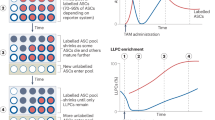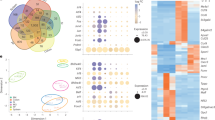Abstract
Plasma cells are of crucial importance for long-term immune protection. It is thought that long-lived plasma cells survive in specialized niches in the bone marrow. Here we demonstrate that bone marrow eosinophils localized together with plasma cells and were the key providers of plasma cell survival factors. In vitro, eosinophils supported the survival of plasma cells by secreting the proliferation-inducing ligand APRIL and interleukin-6 (IL-6). In eosinophil-deficient mice, plasma cell numbers were much lower in the bone marrow both at steady state and after immunization. Reconstitution experiments showed that eosinophils were crucial for the retention of plasma cells in the bone marrow. Moreover, depletion of eosinophils induced apoptosis in long-lived bone marrow plasma cells. Our findings demonstrate that the long-term maintenance of plasma cells in the bone marrow requires eosinophils.
This is a preview of subscription content, access via your institution
Access options
Subscribe to this journal
Receive 12 print issues and online access
$209.00 per year
only $17.42 per issue
Buy this article
- Purchase on Springer Link
- Instant access to full article PDF
Prices may be subject to local taxes which are calculated during checkout







Similar content being viewed by others
References
Ahmed, R. & Gray, D. Immunological memory and protective immunity: understanding their relation. Science 272, 54–60 (1996).
Mamani-Matsuda, M. et al. The human spleen is a major reservoir for long-lived vaccinia virus-specific memory B cells. Blood 111, 4653–4659 (2008).
Manz, R.A., Hauser, A.E., Hiepe, F. & Radbruch, A. Maintenance of serum antibody levels. Annu. Rev. Immunol. 23, 367–386 (2005).
Fairfax, K.A., Kallies, A., Nutt, S.L. & Tarlinton, D.M. Plasma cell development: from B-cell subsets to long-term survival niches. Semin. Immunol. 20, 49–58 (2008).
Smith, K.G., Light, A., Nossal, G.J. & Tarlinton, D.M. The extent of affinity maturation differs between the memory and antibody-forming cell compartments in the primary immune response. EMBO J. 16, 2996–3006 (1997).
Shapiro-Shelef, M. & Calame, K. Regulation of plasma-cell development. Nat. Rev. Immunol. 5, 230–242 (2005).
Radbruch, A. et al. Competence and competition: the challenge of becoming a long-lived plasma cell. Nat. Rev. Immunol. 6, 741–750 (2006).
Blink, E.J. et al. Early appearance of germinal center-derived memory B cells and plasma cells in blood after primary immunization. J. Exp. Med. 201, 545–554 (2005).
Dilosa, R.M., Maeda, K., Masuda, A., Szakal, A.K. & Tew, J.G. Germinal center B cells and antibody production in the bone marrow. J. Immunol. 146, 4071–4077 (1991).
Benner, R., Hijmans, W. & Haaijman, J.J. The bone marrow: the major source of serum immunoglobulins, but still a neglected site of antibody formation. Clin. Exp. Immunol. 46, 1–8 (1981).
Minges Wols, H.A., Underhill, G.H., Kansas, G.S. & Witte, P.L. The role of bone marrow-derived stromal cells in the maintenance of plasma cell longevity. J. Immunol. 169, 4213–4221 (2002).
Tokoyoda, K., Egawa, T., Sugiyama, T., Choi, B.I. & Nagasawa, T. Cellular niches controlling B lymphocyte behavior within bone marrow during development. Immunity 20, 707–718 (2004).
Hargreaves, D.C. et al. A coordinated change in chemokine responsiveness guides plasma cell movements. J. Exp. Med. 194, 45–56 (2001).
Hauser, A.E. et al. Chemotactic responsiveness toward ligands for CXCR3 and CXCR4 is regulated on plasma blasts during the time course of a memory immune response. J. Immunol. 169, 1277–1282 (2002).
Nie, Y. et al. The role of CXCR4 in maintaining peripheral B cell compartments and humoral immunity. J. Exp. Med. 200, 1145–1156 (2004).
Cassese, G. et al. Plasma cell survival is mediated by synergistic effects of cytokines and adhesion-dependent signals. J. Immunol. 171, 1684–1690 (2003).
Belnoue, E. et al. APRIL is critical for plasmablast survival in the bone marrow and poorly expressed by early-life bone marrow stromal cells. Blood 111, 2755–2764 (2008).
O'Connor, B.P. et al. BCMA is essential for the survival of long-lived bone marrow plasma cells. J. Exp. Med. 199, 91–98 (2004).
Lamb, R.J., Capocasale, R.J., Duffy, K.E., Sarisky, R.T. & Mbow, M.L. Identification and characterization of novel bone marrow myeloid DEC205+Gr-1+ cell subsets that differentially express chemokine and TLRs. J. Immunol. 178, 7833–7839 (2007).
Huard, B. et al. APRIL secreted by neutrophils binds to heparan sulfate proteoglycans to create plasma cell niches in human mucosa. J. Clin. Invest. 118, 2887–2895 (2008).
Mhawech-Fauceglia, P. et al. The source of APRIL up-regulation in human solid tumor lesions. J. Leukoc. Biol. 80, 697–704 (2006).
Mohr, E. et al. Dendritic cells and monocyte/macrophages that create the IL-6/APRIL-rich lymph node microenvironments where plasmablasts mature. J. Immunol. 182, 2113–2123 (2009).
McGarry, M.P. & Stewart, C.C. Murine eosinophil granulocytes bind the murine macrophage-monocyte specific monoclonal antibody F4/80. J. Leukoc. Biol. 50, 471–478 (1991).
Lee, J.J. et al. Interleukin-5 expression in the lung epithelium of transgenic mice leads to pulmonary changes pathognomonic of asthma. J. Exp. Med. 185, 2143–2156 (1997).
Chu, V.T., Enghard, P., Riemekasten, G. & Berek, C. In vitro and in vivo activation induces BAFF and APRIL expression in B cells. J. Immunol. 179, 5947–5957 (2007).
Yu, C. et al. Targeted deletion of a high-affinity GATA-binding site in the GATA-1 promoter leads to selective loss of the eosinophil lineage in vivo. J. Exp. Med. 195, 1387–1395 (2002).
Lee, J.J. et al. Defining a link with asthma in mice congenitally deficient in eosinophils. Science 305, 1773–1776 (2004).
Berek, C., Berger, A. & Apel, M. Maturation of the immune response in germinal centers. Cell 67, 1121–1129 (1991).
Berek, C. & Milstein, C. Mutation drift and repertoire shift in the maturation of the immune response. Immunol. Rev. 96, 23–41 (1987).
Spencer, L.A. & Weller, P.F. Eosinophils and Th2 immunity: contemporary insights. Immunol. Cell Biol. 88, 250–256 (2010).
Löhning, M. et al. Long-lived virus-reactive memory T cells generated from purified cytokine-secreting T helper type 1 and type 2 effectors. J. Exp. Med. 205, 53–61 (2008).
Zimmermann, N. et al. Siglec-F antibody administration to mice selectively reduces blood and tissue eosinophils. Allergy 63, 1156–1163 (2008).
Nagase, H. et al. Expression of CXCR4 in eosinophils: functional analyses and cytokine-mediated regulation. J. Immunol. 164, 5935–5943 (2000).
Ma, Q., Jones, D. & Springer, T.A. The chemokine receptor CXCR4 is required for the retention of B lineage and granulocytic precursors within the bone marrow microenvironment. Immunity 10, 463–471 (1999).
Jordan, M.B., Mills, D.M., Kappler, J., Marrack, P. & Cambier, J.C. Promotion of B cell immune responses via an alum-induced myeloid cell population. Science 304, 1808–1810 (2004).
McKee, A.S. et al. Alum induces innate immune responses through macrophage and mast cell sensors, but these sensors are not required for alum to act as an adjuvant for specific immunity. J. Immunol. 183, 4403–4414 (2009).
He, B. et al. Intestinal bacteria induce T cell-independent IgA2 class switching by linking epithelial cells with lamina propria B cells through APRIL. J. Immunol. 28, 812–826 (2007).
Cerutti, A. Location, location, location: B-cell differentiation in the gut lamina propria. Mucosal Immunol. 1, 8–10 (2008).
Juhlin, L. & Michaelsson, G. A new syndrome characterised by absence of eosinophils and basophils. Lancet 1, 1233–1235 (1977).
Hogan, S.P. Recent advances in eosinophil biology. Int. Arch. Allergy Immunol. 143 (Suppl. 1), 3–14 (2007).
Acknowledgements
We thank N.A. Lee (Mayo Clinic, Scottsdale, Arizona, USA) for MBP-specific antibody; the members of the Deutsches Rheuma-Forschungszentrum, in particular T. Kaiser, for technical support; and R.S. Jack, A. Hegazy and A. Radbruch for critical reading of the manuscript. Supported by Deutsche Forschungsgemeinschaft (BE 1171/2-1 to C.B.; SFB 618 and SFB 650 to M.L.), Bundesministerium für Bildung und Forschung (0315267D to M.L.), the Volkswagen Foundation (Lichtenberg Professorship to M.L.) and the Berlin Senate of Research and Education (to Deutsches Rheuma-Forschungszentrum).
Author information
Authors and Affiliations
Contributions
V.T.C., C.B. and M.L. designed experiments and analyzed the data; V.T.C. did most of the experiments; A.F. and M.L. analyzed the immune response to LCMV; T.S. analyzed the GC response; J.J.L. contributed the PHIL mouse and eosinophil-specific antibodies; T.R. and G.S. helped with data acquisition; and V.T.C., C.B., M.L., A.F. and S.F. prepared the manuscript.
Corresponding author
Ethics declarations
Competing interests
The authors declare no competing financial interests.
Supplementary information
Supplementary Text and Figures
Supplementary Figures 1–11 and Supplementary Table 1 (PDF 1278 kb)
Rights and permissions
About this article
Cite this article
Chu, V., Fröhlich, A., Steinhauser, G. et al. Eosinophils are required for the maintenance of plasma cells in the bone marrow. Nat Immunol 12, 151–159 (2011). https://doi.org/10.1038/ni.1981
Received:
Accepted:
Published:
Issue Date:
DOI: https://doi.org/10.1038/ni.1981
This article is cited by
-
Eosinophile in der HNO-Heilkunde: Freund oder Feind?
HNO (2024)
-
Eosinophils in the tumor microenvironment: implications for cancer immunotherapy
Journal of Translational Medicine (2023)
-
Investigating immune profile by CyTOF in individuals with long-standing type 1 diabetes
Scientific Reports (2023)
-
Neonatal LTβR signaling is required for the accumulation of eosinophils in the inflamed adult mesenteric lymph node
Mucosal Immunology (2022)
-
Severe and Difficult Asthma: Diagnosis and Management—Challenges for a Low-Resource Environment
Indian Journal of Pediatrics (2022)



